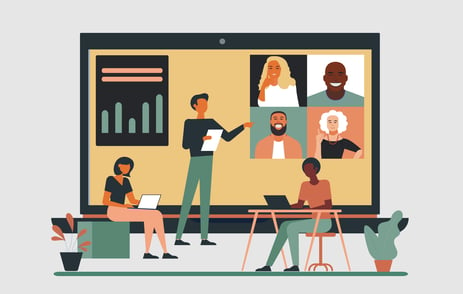Open your computer and chances are you have more than a few programs you use daily – Microsoft Office for all your work and communication, Skype for your meetings or maybe Adobe reader to go through PDFs and other organizational documents. These programs are maintained and updated by their respective creators using proprietary software, which is why they’re often known as proprietary or commercial software.
The direct counter to this ideology is open-source software. So what is it, how does it work and why should associations know about it? Let’s dive into it.
What Is Open-Source Software
Unlike closed source software programs, which are kept protected by their creators, open-source software is open to the public and designed to be enhanced by a community of contributors.
According to Business Insider, “open-source software authors do not view their creations as proprietary and instead release their software under licenses that grant users with the desire and know-how to view, copy, learn, alter, and share its code.”
Common examples of open-source software you may use daily include:
- WordPress – One of the most popular content management systems on the market, powering 34% of sites online. There are over 500 sites built on the platform daily, with access to over 55,000 plugins for customization.
- MySQL Databases – Developed in 1995, MySQL Database is a data storage platform used in web development. Today it makes up 44% of the market share for database management tools, and “customized versions of the open-source software is used to power Twitter, Facebook, and YouTube.”
- Mozilla Firefox – While it may not own the largest market share of web browsers, the open-source aspect of Mozilla Firefox makes it one of the most customizable. Users can easily edit and manage website builds using their developer platform while also troubleshooting errors and performance bottlenecks.
How Can Associations use it?
While there is undoubtedly a technical side of open-source software, where programmers are actively tinkering and tooling with source codes, that’s not likely the application for associations. Instead, your organization's access to this software will likely come from a third-party commercial company that provides support.
These organizations provide more refined versions of this software as well. “These products are optimized for use in a corporate environment – they are easy to install, run smoothly and customers receive regular updates, patches, and support,” says Elmar Geese, Chief Operating Officer of Greenbone.
For example, WordPress.org is open-source software that you can use to build and manage your website. However, to host and support said website, you need a third-party commercial company like WordPress.com, GoDaddy or AWS. This is the same relationship your organization will likely have with open-source software.
Benefits & Challenges of Open Source Software
Open-source software is not a new concept and is used widely today by organizations looking to modify and customize applications and programs based on their needs, which is its biggest benefit. According to IBM, “this philosophy is based on intellectual freedom and core principles: transparency, collaboration, delivery, inclusion, and community.”
For associations, the implications of open-source software could be significant. Having direct access to the software code for key systems opens up a world of flexibility and of course, the free nature of open source projects could reduce a variety of IT and software costs. However, like any innovation, there are benefits and challenges.
The Benefits
When determining whether or not an open-source software solution is right for your organization, it’s good to think of the perks.
- Cost – Open-source software is often free or inexpensive – although some organizations choose to work with third-party vendors who provide support, management or hosting on top of the free software. But overall, the cost is usually considerably less than commercial software options.
- Flexibility – Open-source software is designed to be customized and personalized based on your organizational needs. If there needs to be an update or change for functionality, you (or your support team) can make one yourself.
- Freedom – Because your organization won't have a vendor that "locks you in" to a particular software path, you have the freedom to move your application anywhere on any hosting environment, giving you a choice on how you use and manage your software.
- Security – Most larger open-source projects have consistent track records for security because so many people are looking at the code daily. This allows them to spot any errors or vulnerabilities and patch them before being exploited. This is also why keeping your software up to date is vital for protecting your platform.
The Challenges
Open-source software can also have challenges that make it less appealing to associations, including:
- Options – While freedom is one of the benefits of open-source software, it can also be a challenge. Not only will your organization have an option of software to use, but also they’ll need to choose a third-party provider. Without a wide range of knowledge or experience in selecting providers, this can lead to downtime or support issues for your platform.
- Security – Just as the open-source community provides a sense of security, it also creates a liability. Not only do hackers have easier access to source code and potential weaknesses (because they’re being discussed in the open), but also, open-source software is continually updated and built upon itself. Meaning, there may be an exploitable old piece of software in a newer “secure” offering, creating an exploitable weakness in your platform.
- As an example, in 2021, Log4J created a security liability for organizations all around the world. It allowed hackers to take over software using code strings and affected programs as large as Minecraft.
- Today, there are organizations explicitly created to find and patch these vulnerabilities. The Open Source Security Foundation (OpenSSF), for example, partners with major companies, including Google, to analyze vulnerabilities. In a recent project, they noted 200 malicious attacks in the span of a month.
While security is a concern, challenges are avoidable with some best practices. Microsoft recommends inventorying all your open-source software, checking for public vulnerabilities and aligning your IT efforts around quick response times in the event of an attack.
Modifying Open-Source Software
If someone wanted to create a derivative product based on an open-source project, they would need to study the licensing scheme for that project to determine what was allowed and any requirements (such as attribution to the original project). However, this software lives publicly on the web and has dedicated communities that modify and maintain it for free use, which is how the vast majority of users interact with it.
What It Means for Sidecar’s Platform
So, what does open-source software have to do with Sidecar’s platform rebuild?
Well, everything. As we mentioned in the principles of our rebuild, our design is based on the idea of openness and flexibility. Not only do we want to have complete ownership of our data, but also we want to be able to adjust our platform based on the needs of our members, which means our design and process are similar to the foundations of open-source software. Additionally, when we’re done designing, we also plan on releasing our IP (the platform we build) as open-source software in partnership with MemberJunction, a Blue Cypress family company. That means you’ll be able to download it and customize it for your association and organizational applications.

June 2, 2022


